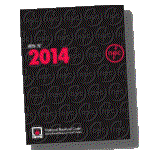|
Home >
Building Codes > NFPA Codes & Related |
NFPA Codes, Related References & Guides |
|
|
|||
2017 NEC
& Related Products |
|||
 2014 NEC & Related |
|||
|
NFPA
70E
Standard for Electrical Safety in the Workplace
2012
- The 2012 NFPA 70E responds to the challenges, making it easier to ensure an electrically safe working area and comply with OSHA 1910 Subpart S and OSHA 1926 Subpart K. Workplace safety in the United States is evolving due to better awareness and implementation of NFPA 70E: Standard for Electrical Safety in the Workplace®. Yet hundreds of deaths and thousands of disabling injuries still occur each year due to shock, electrocution, arc flash, and arc blast -- and most could be prevented through NFPA 70E compliance. Originally developed at OSHA's request, NFPA 70E responds to new information about the effects of arc flash, arc blast, and direct current (dc) hazards, and recent developments in electrical design and Personal Protective Equipment (PPE). |
||
|
A User's Guide to Electrical PPE Based on
NFPA 70E - Analyze risks and work smart! Every electrician on the job needs the User's Guide to Electrical PPE. This full-color manual to Personal Protective Equipment (PPE) is a "must" for the practicing electrical contractor or electrician. Based on NFPA 70E®: Standard for Electrical Safety in the Workplace® and written by Ray Jones, the top ranking expert in electrical safety, User's Guide to Electrical PPE helps workers and supervisors competently analyze risks and take the action needed to avoid electrical contract injuries. An abundance of full-color photographs illustrate equipment in a wide variety of work environments. - more |
|||
|
NFPA
90A: Standard for the Installation of Air-Conditioning and
Ventilating Systems,
2012
Edition
- AHJs, architects, contractors, and mechanical and fire protection engineers all need the latest edition of NFPA 90A to ensure adequate fire protection in today's buildings. Follow the new, industry-approved HVAC standard of care, the 2012 NFPA 90A: Standard for the Installation of Air-Conditioning and Ventilating Systems. Vital to fire and life safety, the 2012 edition of NFPA 90A addresses every aspect of the construction, operation, and maintenance of air conditioning and ventilating systems, including filters, ducts, and related equipment. Staying up-to-code is essential to protect life and property from fire, smoke, and gases resulting from fire or conditions having manifestations similar to fire. |
||
|
NFPA 90B:
Standard for the Installation of Warm Air Heating and
Air-Conditioning Systems, 2012
Edition - NFPA 90B: Standard for the Installation of Warm Air Heating and Air-Conditioning Systems provides the most up-to-date requirements to keep fire, smoke and gases from originating in and spreading through indoor HVAC systems in small buildings and 1- and 2-family dwellings. The requirements cover construction, installation, operation, and maintenance of systems for warm air heating and air conditioning, including filters, ducts, and related equipment to protect lives and property from fire, smoke, and gases resulting from fire or conditions having manifestations similar to fire. Don't fall behind. AHJs, architects, contractors, and mechanical and fire protection engineers depend on the latest NFPA 90B for vital fire protection information. |
||
|
|||
|
|
|||
|
***************************************************************** |
|||